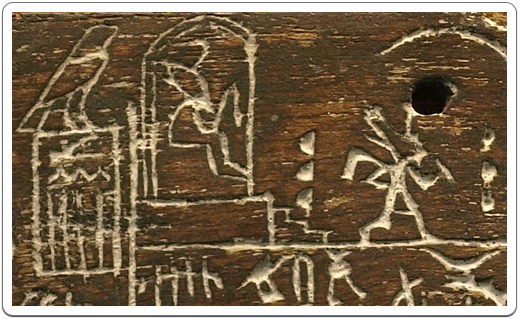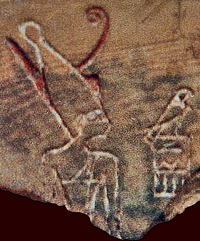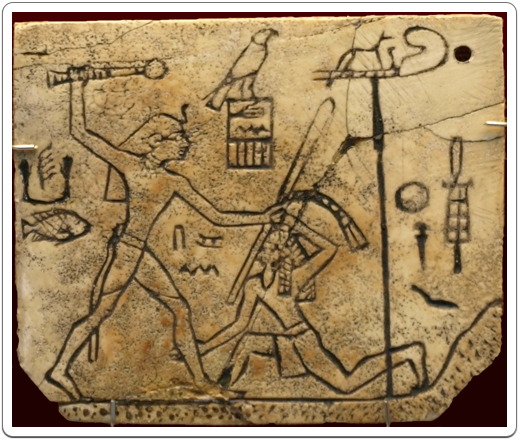Horus Den ascended to the throne after the relatively short reign of Horus Djet, when he was still a child. This placed his mother, Merneith, in the position of queen regent to rule in the place of her son, as is shown by many sources, including a seal impression where her name is written in a serekh. The duration of her regency is not known, but it is clear from her tomb at Umm el-Qa’ab that Den provided her with a burial and funerary cult fit for a king.
At least two other queens, his wives, are associated with Den: Semat, Nakhtneith, Serethor and Seshemetka with whom he had several children. His relationship with jis successor, Horus Anedjib, is not known.
Manetho credits Den with a reign of 20 years. The Turn King-List is damaged at the spot where Den is mentioned, making it impossible to ascertain how many years this source credits him. The Oxford fragment of the Annals Stone records 4 years of his reign, Cairo Fragment CF5 lists 5 years and the Palermo Fragment 14 years, totaling 23 years. As these three fragments are not adjacent, it can safely be assumed that Den ruled for much more than 23 years.

Detail of the year label that shows Den’s Heb-Sed celebration. In front of his Horus Name, the king sits on a throne in a raised dais. He holds a sceptre in his hands and wears the Double Crown. The scene in front of him, depicts the king’s ritual run, as part of the festival.
A year label has recorded a Heb-Seb celebration, a royal jubilee that was normally celebrated the first time during the 30th year of a king’s reign and every 3 years from then on, for Den. It shows the king wearing the typical short dress associated with the festival, while seated on a throne. Another scene on the label has the king doing a ritual run which was part of the festival.
That the king indeed celebrated this festival is confirmed by a small ivory statuette where he wears the White Crown and the short Heb-Sed dress.
The 3rd year cell on the Palermo Fragment also records the king’s second Heb-Sed. If Den indeed held his second Heb-Sed in the 33rd year of his reign, then he ruled at least for 33 years. But even if his 2nd Heb-Sed was earlier in his reign, it is generally accepted that Den ruled for at least 41 years.

Den wearing the Double Crown.
Den is the first king known to have held the title “King of Upper and Lower Egypt”, which would become an important part of the royal titulary.
He may also be the first king to have been represented wearing the Double Crown, a combination of the White and the Red Crowns, which, by this time, had probably come to symbolise Upper and Lower Egypt respectively, as may be shown by some labels dated to the reign of Horus Djet where the snake of the Lower Egyptian goddess Uto was replaced by the Red Crown. The combination of both crowns into one, as well as the introduction of the new title, points to Den’s reign as having the last step in the evolution of the definition of Egypt as the unity between two countries, Upper and Lower Egypt.
Several finds throughout the country, including lavish tombs at Saqqara and Abu Rawash in the north of the Memphite necropolis, dated to Den’s reign, bear witness of the country’s wealth and prosperity. The oldest known funerary boat is dated to the reign of Den and was found at Abu Rawash.
An ivory label shows Den, wearing either a long wig or the precursor of the nemes headdress, striking down a foe during his first campaign against the east. The reference to the east may be somewhat vague and may refer to Egypt’s Eastern Desert, as well as to Sinai or Syria-Palestine, but the way the foe is stylised, with a curly wig and a beard, may well place this victory in Syria-Palestine.

Den’s first victory in the east, smiting down an Asiatic looking enemy on the so-called MacGregor label.
Den was buried in a tomb, labeled Tomb T, at Umm el-Qa’ab, the first royal tomb to have had a staircase descending down into it. It is one of the largest tombs in the cemetery, yet another witness to Egypt’s wealth and prosperity during his reign.